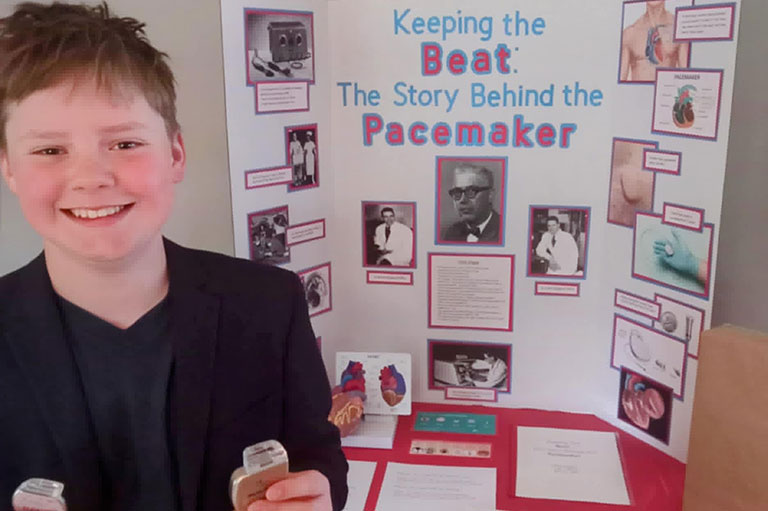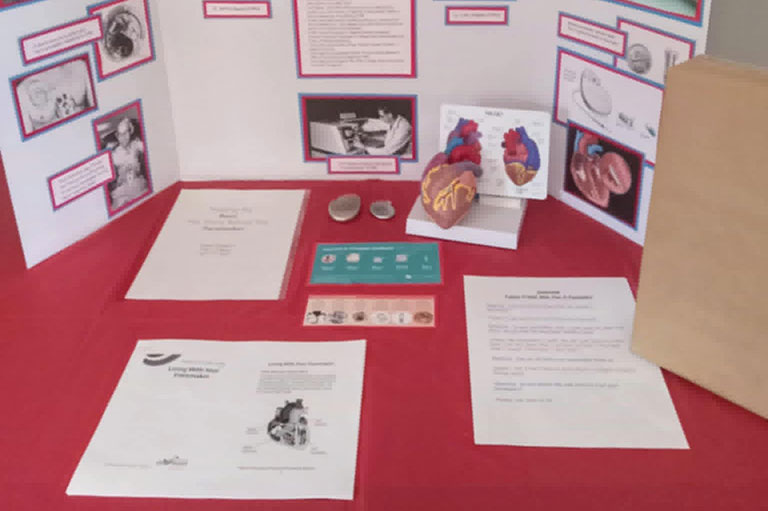Dawson D.

Keeping the Beat:The Story Behind the Pacemaker
Dawson D.
South Shore Regional Centre for Education Heritage Fair
Bridgewater, NS
The story began in 1949, when 2 researchers at the Banting Institute in Toronto by the names of Dr. Wilfred Bigelow and Dr. John Callaghan were doing research on dogs to see if they could use hypothermia to slow down the heart enough to preform open heart surgery.They wanted to do this to see if there would be less complications to the heart and brain so that they could use this method on humans. While they were doing this research, an engineer by the name of John Hopps was hired to help them with this experiment.
One day when a dog’s heart stopped beating, they decided to use radio frequency to try and warm up the dog’s body. They discovered that small electrical impulses made the dog’s heart contract and beat again. This was a breakthrough for Bigelow and Callaghan, but they did not have the knowledge to be able to create a device that could restart a heart using electricity. Bigelow and Callaghan asked Hopps if he could help them out.
By 1950, Hopps had created the world's first external artificial pacemaker. It was the size of a thick cereal box so obviously it was too big to be implanted. Hopps worked with Dr. Bigelow to improve the design and in 1951 they introduced the Model 3 Stimulator-Defibrillator pacemaker for humans. This pacemaker had to sit on a cart, and it needed to be plugged into the wall. Vacuum tubes were used to generate pulses.
Hopps tried to patent his design, but it was denied. That meant that other doctors and inventers could use his design to help develop the implantable pacemaker. Although John Hopps did not create the pacemaker that we know today, it was his invention in 1950 that paved the way to this amazing technology.
What sources and evidence did you consult for your project? What different perspectives did they provide on your topic?
I used several sources for my project. First of all, I read articles that talked about the invention of the pacemaker. Some of these articles were about John Hopps and other articles talked about how people used John Hopps’ design to improve the pacemaker. I also watched a CBC interview with John Hopps and other videos that explained what a pacemaker was or showed people what to expect when they went to the hospital to get a pacemaker implanted. Lastly, I wanted to get a personal perspective of someone who had a pacemaker and how it has made a difference in their life so I interviewed a family friend.

What is the historical significance of your topic?
The pacemaker has changed a lot over the last 76 years. It started out as a bulky, external tabletop device that had to be plugged into the wall and now it is a small battery-operated device that is about the size of three silver dollars stacked together. Some pacemakers are even smaller than that!
These newer pacemakers are put under the skin, usually close to the collar bone. They are connected to the heart with wires that go through veins to electrodes inside the heart chamber. These wires carry electrical impulses that regulate the heartbeat.
Today’s pacemakers have better wires, better batteries and can use phones to communicate how they are working. Some of the newer pacemakers don't even need wires and can be put directly into the heart.There are also different kinds of pacemakers depending how many chambers in the heart need to be regulated. Pacemakers can be implanted in patients of all ages.The youngest patient I read about was only 15 minutes old and the oldest patient was 107 years old.
Why did you choose this topic?
As with many people, I know several family members and friends who have been diagnosed with heart disease. My 2 grandfathers, my grandmother, and recently, my father and great uncle just to name a few. I wanted to learn more about how Canadians have helped with heart research and I found out that the first pacemaker was actually invented by a Canadian named John Hopps. I decided to research how John Hopps came up with this invention because it is responsible for keeping so many hearts beating around the world.

